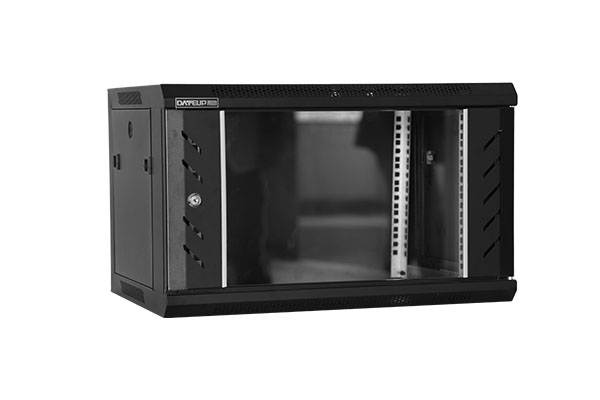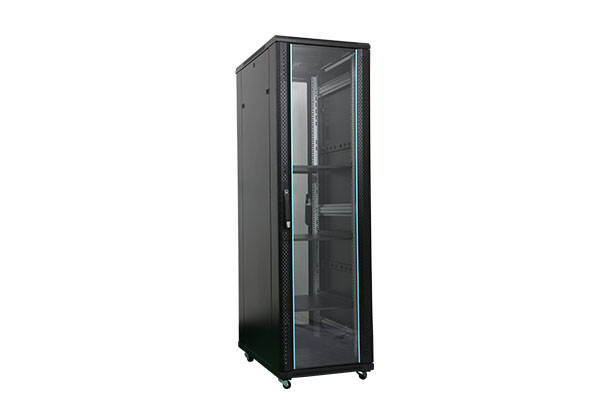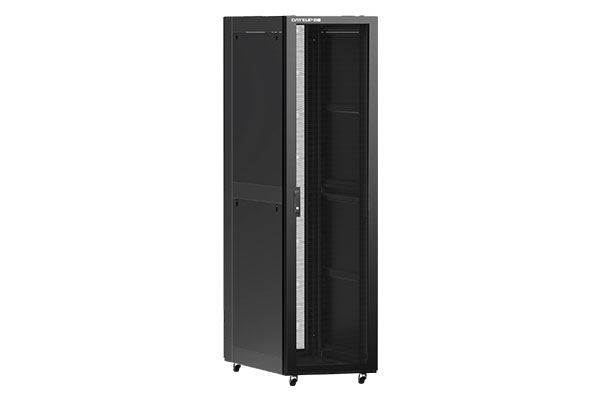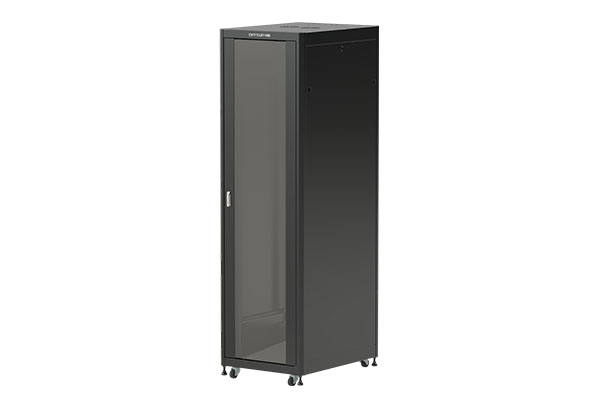What is unique about the cooling system of the mk cabinet that can ensure the stable operation of the equipment?
Release Time : 2025-06-16
In today's digital age, the efficient and stable operation of network equipment is crucial, and the cooling system of the mk cabinet plays a key role in it. With its uniqueness, the cooling system of the mk cabinet provides a solid guarantee for the stable operation of the equipment.
The uniqueness of the cooling system of the mk cabinet is first reflected in its diverse cooling methods. Fan cooling is the most basic and common method. Inside the mk cabinet, there are multiple fans reasonably distributed, which generate strong airflows through high-speed rotation. These airflows are like smart messengers, quickly taking away the heat generated during the operation of the equipment. For example, near the power supply, CPU and other heat-generating components of the server, the fan can be accurately positioned to form an effective air circulation path to ensure that the heat is discharged in time, avoiding the performance degradation or even damage of the equipment due to local overheating.
In addition to fan cooling, liquid cooling technology has gradually been applied in mk cabinets. Liquid cooling transfers heat from the heat-generating components to the radiator through a liquid circulation system, and then the radiator dissipates the heat into the air. Compared with traditional air cooling, liquid cooling has higher heat conduction efficiency. It can take away the heat generated by the equipment more quickly, so that the equipment always remains within the appropriate operating temperature range. Moreover, liquid cooling has lower noise, creating a relatively quiet environment for the computer room, which is conducive to the long-term stable operation of the equipment.
The uniqueness of the mk cabinet cooling system is also reflected in its intelligent temperature control function. The intelligent temperature control system monitors the temperature of various parts in real time through the temperature sensors installed inside the cabinet. These sensors are like keen "sentinels", always paying attention to the temperature changes around the equipment. Once an abnormal temperature rise is detected, the intelligent temperature control system will respond immediately, automatically adjust the fan speed or start the liquid cooling device. For example, when the CPU temperature rises, the system will automatically increase the fan speed, increase the airflow, and quickly cool down; when the temperature drops to a safe range, it will reduce the fan speed to save energy. This dynamic adjustment mechanism can ensure that the equipment can maintain a suitable temperature under different loads, avoid overheating and energy waste, and provide precise temperature control for the stable operation of the equipment.
The cooling system of the mk cabinet also focuses on the overall layout and design. A reasonable internal layout of the cabinet can optimize the airflow path and reduce thermal resistance. Some high-end MK cabinets use special partitions and air guides to guide airflow through key components to ensure that heat is effectively dissipated. At the same time, the design of the cabinet's ventilation holes is also very critical. The location and size of the ventilation holes are carefully designed to ensure that cold air enters the cabinet smoothly and hot air is discharged in time. For example, the mesh cabinet front and rear doors of the Yingke cabinet adopt a high-density mesh design with a very high ventilation rate, just like opening countless small windows for the cabinet, allowing heat to quickly escape and create a cool operating environment for the equipment.
In addition, the MK cabinet cooling system is also combined with the overall environmental control of the computer room. The computer room is usually equipped with an air conditioning system and a humidity control system to maintain a constant temperature and humidity. The air conditioning system controls the temperature of the computer room within a suitable range and provides a good external environment for the MK cabinet. At the same time, the MK cabinet's cooling system works in conjunction with the air supply and exhaust systems of the computer room, optimizing air circulation and improving heat dissipation through the design of underfloor air supply and ceiling exhaust. This overall environmental control strategy further ensures the stable operation of the equipment in the MK cabinet.
The cooling system of mk cabinet has shown unique advantages with its diversified cooling methods, intelligent temperature control function, reasonable layout design and coordination with the overall environment of the computer room. These advantages work together to provide all-round guarantee for the stable operation of network equipment and ensure the efficiency and reliability of network communication in the digital age.
The uniqueness of the cooling system of the mk cabinet is first reflected in its diverse cooling methods. Fan cooling is the most basic and common method. Inside the mk cabinet, there are multiple fans reasonably distributed, which generate strong airflows through high-speed rotation. These airflows are like smart messengers, quickly taking away the heat generated during the operation of the equipment. For example, near the power supply, CPU and other heat-generating components of the server, the fan can be accurately positioned to form an effective air circulation path to ensure that the heat is discharged in time, avoiding the performance degradation or even damage of the equipment due to local overheating.
In addition to fan cooling, liquid cooling technology has gradually been applied in mk cabinets. Liquid cooling transfers heat from the heat-generating components to the radiator through a liquid circulation system, and then the radiator dissipates the heat into the air. Compared with traditional air cooling, liquid cooling has higher heat conduction efficiency. It can take away the heat generated by the equipment more quickly, so that the equipment always remains within the appropriate operating temperature range. Moreover, liquid cooling has lower noise, creating a relatively quiet environment for the computer room, which is conducive to the long-term stable operation of the equipment.
The uniqueness of the mk cabinet cooling system is also reflected in its intelligent temperature control function. The intelligent temperature control system monitors the temperature of various parts in real time through the temperature sensors installed inside the cabinet. These sensors are like keen "sentinels", always paying attention to the temperature changes around the equipment. Once an abnormal temperature rise is detected, the intelligent temperature control system will respond immediately, automatically adjust the fan speed or start the liquid cooling device. For example, when the CPU temperature rises, the system will automatically increase the fan speed, increase the airflow, and quickly cool down; when the temperature drops to a safe range, it will reduce the fan speed to save energy. This dynamic adjustment mechanism can ensure that the equipment can maintain a suitable temperature under different loads, avoid overheating and energy waste, and provide precise temperature control for the stable operation of the equipment.
The cooling system of the mk cabinet also focuses on the overall layout and design. A reasonable internal layout of the cabinet can optimize the airflow path and reduce thermal resistance. Some high-end MK cabinets use special partitions and air guides to guide airflow through key components to ensure that heat is effectively dissipated. At the same time, the design of the cabinet's ventilation holes is also very critical. The location and size of the ventilation holes are carefully designed to ensure that cold air enters the cabinet smoothly and hot air is discharged in time. For example, the mesh cabinet front and rear doors of the Yingke cabinet adopt a high-density mesh design with a very high ventilation rate, just like opening countless small windows for the cabinet, allowing heat to quickly escape and create a cool operating environment for the equipment.
In addition, the MK cabinet cooling system is also combined with the overall environmental control of the computer room. The computer room is usually equipped with an air conditioning system and a humidity control system to maintain a constant temperature and humidity. The air conditioning system controls the temperature of the computer room within a suitable range and provides a good external environment for the MK cabinet. At the same time, the MK cabinet's cooling system works in conjunction with the air supply and exhaust systems of the computer room, optimizing air circulation and improving heat dissipation through the design of underfloor air supply and ceiling exhaust. This overall environmental control strategy further ensures the stable operation of the equipment in the MK cabinet.
The cooling system of mk cabinet has shown unique advantages with its diversified cooling methods, intelligent temperature control function, reasonable layout design and coordination with the overall environment of the computer room. These advantages work together to provide all-round guarantee for the stable operation of network equipment and ensure the efficiency and reliability of network communication in the digital age.







